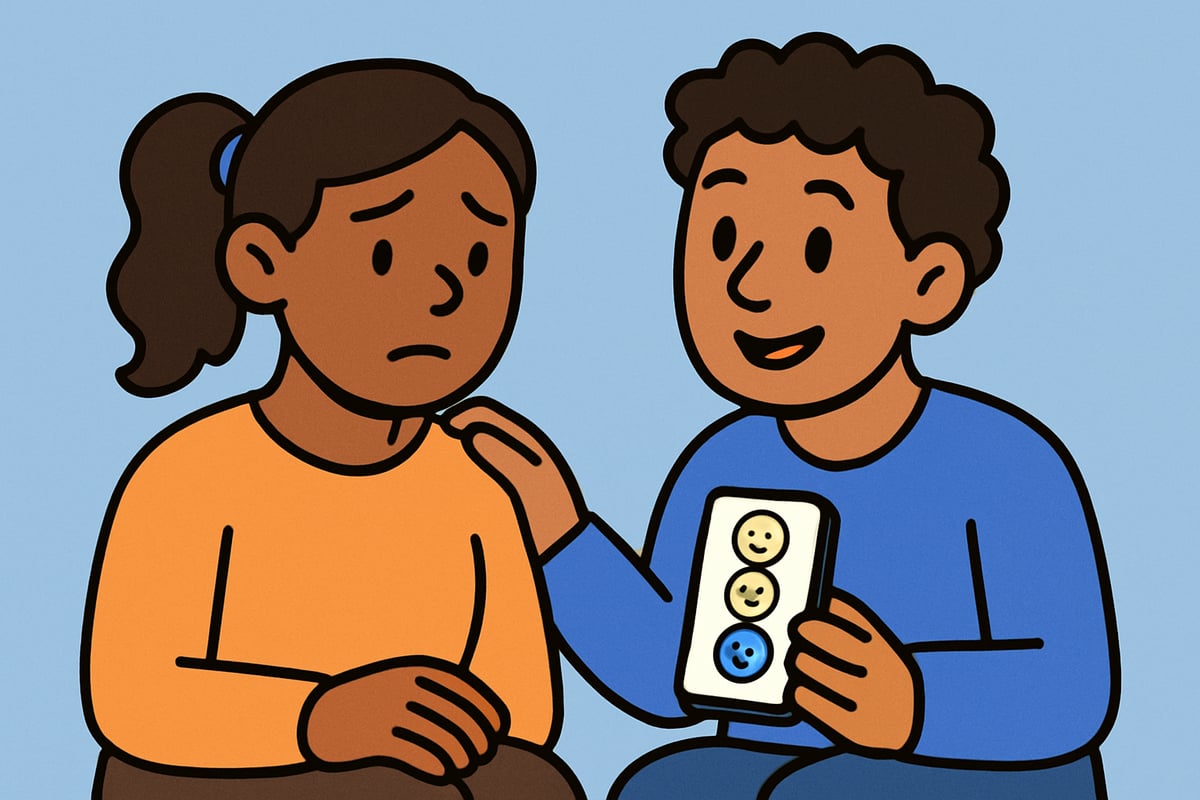Guide to Share Your Feelings Authentically in 2025
In an age of digital connection and emotional complexity, finding the courage to share your feelings can feel both more important and more challenging than ever. Authentic emotional expression is the key to building deeper relationships and improving your own well-being.
This guide will show you how to share your feelings in ways that feel genuine, safe, and supportive in 2025. You will discover why expressing emotions matters, how to move past common barriers, step-by-step methods for honest sharing, and the latest tools to help you communicate more openly. Start your journey toward stronger connections and emotional growth here.
The Importance of Sharing Your Feelings Authentically
In our fast-paced, hyper-connected world, the need to share your feelings authentically has never been more vital. Genuine emotional expression is the heartbeat of healthy relationships and personal well-being. Yet, many still struggle with opening up, especially as digital interactions become more common.
Emotional expression is directly linked to mental health. When you share your feelings, you invite understanding, empathy, and connection. Studies show that emotional suppression leads to higher stress levels and can damage relationships over time. For example, people who bottle up emotions tend to experience more conflict, loneliness, and even physical health problems. According to Verywell Mind, 83% of people report improved relationships when they openly share their feelings.
Authentic sharing goes beyond casual conversation. It builds intimacy and trust, allowing relationships to deepen and grow. When you share your feelings honestly, you show vulnerability, which encourages others to do the same. This mutual openness strengthens bonds and creates a foundation for personal growth.
The digital age has changed how we communicate. In 2025, much of our interaction happens online, making it both easier and harder to share your feelings. Texts and messages can sometimes feel safer, but they lack the nuance of face-to-face communication. Emojis and short replies can’t always capture the depth of what you truly feel.
It is crucial to distinguish between sharing thoughts and sharing feelings. Consider the difference:
| Statement | Thought or Feeling? |
|---|---|
| “I think you’re ignoring me” | Thought |
| “I feel hurt” | Feeling |
| “You never listen to me” | Thought |
| “I feel lonely” | Feeling |
When you share your feelings instead of just your thoughts, your message becomes clearer and more meaningful. For instance, saying “I feel anxious when plans change” invites understanding, while “You always change plans” may lead to defensiveness.
Recent years have brought a societal shift toward embracing vulnerability. More people recognize the value of emotional honesty, and communities are increasingly supportive of open sharing. Encouragement to share your feelings is growing in schools, workplaces, and online spaces.
However, the risks of bottling up emotions remain real. Suppressed feelings can lead to misunderstandings, unresolved conflicts, and a deep sense of isolation. Research highlights that emotional suppression can reduce social support and satisfaction, especially during major life transitions. For a deeper look at these effects, you can read about The Social Costs of Emotional Suppression.
Learning to share your feelings authentically is a skill that nurtures trust, strengthens relationships, and boosts your emotional resilience. It’s not always easy, but the rewards are worth it. By making space for your emotions and expressing them honestly, you invest in your own well-being and the health of your connections.

Common Barriers to Authentic Emotional Expression
Opening up and learning to share your feelings can feel daunting. There are many invisible walls that stand between us and honest expression. Understanding these barriers is the first step toward breaking them down and building real connection.

Fear of Judgment, Rejection, or Conflict
One of the most common reasons people hesitate to share your feelings is the fear of being judged or misunderstood. Many worry that being honest about emotions could lead to rejection or even conflict with loved ones. This fear often keeps people silent, even when they long for support or understanding.
When you share your feelings, you may wonder if others will see you as weak or overly sensitive. These worries can make it easier to stay quiet, but this silence only deepens the gap between you and those around you.
Cultural and Gender Norms
Cultural expectations and gender roles often shape how comfortable you feel when you try to share your feelings. In some cultures, showing emotion is seen as a sign of strength, while in others, it may be discouraged. For men, especially, outdated stereotypes can make it difficult to express vulnerability without feeling ashamed.
Gender norms can teach people to bottle up emotions, believing that talking about feelings is not “manly” or “appropriate.” Unfortunately, these beliefs can make it harder for everyone to connect on a deeper level.
Internalized Beliefs and Emotional Vocabulary
Sometimes, the struggle to share your feelings comes from within. You might believe that your emotions are not valid, or that expressing them would make you a burden to others. These internalized beliefs can be powerful obstacles, even when you want to be open.
Another barrier is lacking the words to describe what you are feeling. Without a strong emotional vocabulary, it is easy to confuse feelings with thoughts or moods. This makes it harder to communicate clearly and be truly understood.
| Barrier | Impact on Sharing Feelings |
|---|---|
| Fear of rejection | Silence, isolation |
| Cultural/gender expectations | Suppression, shame |
| Internalized beliefs | Self-doubt, withdrawal |
| Limited vocabulary | Miscommunication, frustration |
The Role of Social Media
Digital platforms can be both a help and a hindrance when you want to share your feelings. On one hand, social media offers a space to connect with others and find support. On the other, it can encourage shallow interactions and present unrealistic standards for emotional sharing.
People often feel pressure to present a “perfect” image online, making it tough to admit when they are struggling. This can lead to emotional suppression and a sense of loneliness, especially when it seems like everyone else is doing just fine.
Common Scenarios and Data
Think about times when you have wanted to share your feelings but held back. Maybe you avoided telling a friend you were hurt, or kept quiet during a tense family discussion. These moments are more common than you might think.
Research shows that emotional invalidation increases anxiety and lowers satisfaction in relationships. In fact, studies have found that emotional suppression can negatively impact well-being and connection, especially in close partnerships. According to Emotional Suppression and Psychological Well-Being in Marriage, holding back emotions can harm both mental health and relationship satisfaction.
Recognizing these barriers is the first step to overcoming them. Remember, you are not alone in your struggle to share your feelings. With patience and practice, it is possible to break through these walls and find authentic connection.
Step-by-Step Guide to Sharing Your Feelings Authentically
Opening up and learning to share your feelings takes courage, but it is an essential skill for building meaningful relationships and nurturing your emotional health. This step-by-step guide will walk you through the process, helping you move from self-awareness to genuine connection.

Step 1: Accept and Identify Your Feelings
Before you can share your feelings, you first need to recognize and accept them. Emotional acceptance means allowing your feelings to exist without judgment or trying to push them away. This step is about giving yourself permission to feel, no matter what arises.
Start by practicing mindfulness. Take a few deep breaths and notice what emotions are present. Are you feeling tense, sad, excited, or maybe a mix? Journaling is another helpful tool—write down what you’re experiencing, even if it feels messy or unclear.
Naming your emotions is powerful. For example, try listing words like "angry," "embarrassed," "happy," "hurt," "sad," or "scared." Research shows that affect labeling, or putting your feelings into words, can actually reduce their intensity and help you manage them better.
It’s easy to confuse feelings with thoughts or moods. For example, "I feel like no one cares" is a thought, while "I feel lonely" is an emotion. Distinguishing the difference allows you to share your feelings more clearly.
Remember, all emotions are valid. Avoid criticizing yourself for what you feel. Instead, treat each feeling as a message worth listening to. This self-compassion lays the foundation for authentic sharing.
When you accept your emotions without resistance, you become more equipped to share your feelings with others in a genuine way.
Step 2: Clarify and Label Your Emotions
Once you’ve accepted what you’re feeling, the next step is to clarify and label those emotions with accuracy. Building an emotional vocabulary helps you share your feelings in a way others can understand.
Consider using a feelings word list or an emotion wheel to pinpoint exactly what you’re experiencing. The difference between saying "I feel hurt" and "I think you’re unfair" is significant—the first expresses a feeling, the second a judgment.
Specificity is key. Instead of vague statements, aim for clear descriptions. Practice saying your feelings aloud or writing them down: "I feel anxious about the upcoming meeting" or "I feel proud of my progress."
The more precise you are, the easier it is for others to understand and support you. Plus, clear labeling helps you avoid miscommunication and deepens your self-awareness.
Try this exercise: Choose a recent situation and write down the exact emotions you experienced. Notice how the words you select shape your understanding.
Developing this skill makes it much easier to share your feelings authentically, setting the stage for honest conversations.
Step 3: Choose the Right Time and Environment
Timing and context play a huge role when you want to share your feelings. Vulnerable conversations require safe, supportive spaces where you feel comfortable and respected.
Look for moments when both you and the other person are calm and not distracted. Avoid high-stress situations or times when either of you is rushed or upset. Creating a peaceful environment—maybe a quiet room or a relaxing walk—can make a big difference.
Consider setting intentional check-ins with loved ones. For example, you might agree to talk about feelings during an evening walk or over coffee on Sunday mornings.
A supportive setting allows you to share your feelings with less fear of judgment or misunderstanding. It also signals to the other person that you value the conversation and their presence.
Choosing the right time and place demonstrates respect for both your emotions and the relationship, making authentic sharing more likely to succeed.
Step 4: Express Your Feelings Clearly and Honestly
When you’re ready to share your feelings, use direct and honest language. “I feel” statements are a simple yet effective way to claim ownership of your emotions. For example, “I feel anxious when plans change last minute” is more constructive than “You always ruin things.”
Avoid blaming, minimizing, or dismissing your experience. Steer clear of phrases like “It’s not a big deal, but…” or “You made me feel…” Instead, focus on what you’re experiencing and why it matters to you.
Body language and tone are just as important as words. Maintain open posture, gentle eye contact, and a calm voice. These nonverbal cues reinforce your sincerity and invite understanding.
Balance honesty with empathy for the listener. Acknowledge their feelings and perspective while staying true to your own. You might say, “I know this might be hard to hear, but I want to be honest about how I’m feeling.”
If you struggle with this step, remember that practice makes progress. The more you share your feelings in a clear, honest way, the more natural and comfortable it will become.
Step 5: Invite Open Dialogue and Practice Active Listening
Authentic emotional sharing is a two-way street. Once you share your feelings, invite the other person to respond and express their own emotions. This creates a safe, supportive environment for real connection.
Use reflective listening techniques, such as paraphrasing what the other person says or asking open-ended questions like, “How does that make you feel?” or “Tell me more about your experience.” These strategies show that you value their perspective and encourage deeper conversation.
Validation is crucial. Avoid dismissive or defensive responses. Instead, affirm the other person’s emotions, even if you don’t fully agree. You might say, “I understand that this was difficult for you,” or “Thank you for sharing that with me.”
If you’re looking for additional support or practice, consider exploring our companions for emotional support, who can help you build confidence in sharing your feelings in a nonjudgmental space.
By inviting open dialogue and really listening, you not only share your feelings but also foster trust and intimacy in your relationships.
Tools and Techniques for Authentic Emotional Sharing in 2025
Navigating new tools and strategies can make it easier than ever to share your feelings in healthy and authentic ways. Let’s explore how technology, empathy, mindfulness, and daily habits can support your emotional journey and help you build deeper connections in 2025.

Leveraging Technology for Emotional Expression
In 2025, technology offers creative ways to share your feelings both privately and with others. Mood-tracking apps help you spot emotional patterns over time, making it easier to recognize what you’re experiencing. Digital journals and AI companions can act as safe spaces for self-reflection, letting you process emotions before reaching out to someone you trust.
There are pros and cons to using text-based platforms compared to face-to-face conversations. Texting can feel less vulnerable and gives you more time to find the right words, while in-person chats allow for body language and immediate feedback. Both can help you share your feelings, so choose what feels right for you.
If you’re looking for a safe, judgment-free listener, consider reaching out to someone to talk to online. These platforms connect you with supportive people who can help you practice opening up, especially if sharing your feelings face-to-face feels intimidating.
Practicing Emotional Validation and Empathy
Validation and empathy are essential tools when you share your feelings. Science shows that feeling heard and understood can calm your nervous system and improve relationships. To validate someone’s emotions, try reflecting back what you hear, such as, “It sounds like you’re feeling frustrated.” This simple act demonstrates care and respect.
- Paraphrase what the other person says to confirm understanding.
- Affirm their experience, even if you don’t fully agree.
- Respond without judgment or trying to “fix” the feeling.
Research highlights that emotional validation can help with emotion regulation and lower conflict. When you share your feelings with someone who practices empathy, it becomes easier to open up, trust, and connect.
Incorporating Mindfulness and Self-Compassion
Mindfulness helps you stay present when you share your feelings. Practicing mindful breathing or gentle grounding techniques can reduce anxiety before or during emotional conversations. Self-compassion exercises, like silently repeating kind phrases to yourself, can ease shame and give you courage to be vulnerable.
If you notice self-critical thoughts when you try to share your feelings, pause and remind yourself that all emotions are valid. This gentle approach can make it less scary to express what’s on your heart.
Building Daily Habits for Emotional Sharing
Small daily habits can make it second nature to share your feelings. Try setting aside a moment each evening to check in with yourself or a loved one. You might write down one emotion you felt that day or share it aloud with a friend, family member, or partner.
- Schedule brief daily or weekly check-ins.
- Use simple prompts like, “Today I felt…”
- Encourage others to join you in sharing.
These routines help create supportive environments where sharing feelings is normal and encouraged. Over time, you’ll notice stronger connections and improved emotional well-being.
Fostering Supportive Environments for Emotional Expression
Feeling safe to share your feelings is essential for emotional growth and connection. When you are surrounded by people who respect your emotions, you are more likely to open up and build trust. Supportive environments create a foundation where vulnerability is not just accepted but encouraged, making it easier to express what is on your mind and heart.
Creating Safe Spaces at Home, Work, and Online
Building a supportive space starts with intention. At home, set aside time for regular check-ins where everyone can share your feelings without fear of judgment. In the workplace, leaders can foster trust by encouraging open dialogue and respecting privacy. Online, look for communities that value empathy and set clear guidelines to keep conversations respectful.
Simple steps to create safe spaces:
- Establish ground rules for listening and confidentiality.
- Use inclusive language that validates all emotions.
- Encourage participation without pressure.
When people feel comfortable, they are more likely to share your feelings honestly and openly.
Encouraging Authenticity, Boundaries, and Addressing Invalidation
Modeling authenticity is a powerful way to invite others to share your feelings. When you express your emotions honestly, you set an example that vulnerability is welcome. It is also important to set boundaries, making it clear that everyone’s comfort level is respected.
Addressing invalidating behaviors, like saying “Don’t feel that way,” helps maintain an environment where emotions are valued. If you notice someone shutting down, gently ask how you can support them. Remember, every person deserves to share your feelings at their own pace.
The Impact of Emotional Support and Practical Examples
Supportive environments are linked to greater resilience, better mental health, and stronger relationships. When you feel understood, you are more likely to face challenges with confidence. Family rituals, like sharing one thing you felt each day at dinner, or team check-ins at work, make it routine to share your feelings.
| Example Rituals | Description |
|---|---|
| Family dinner check-ins | Everyone shares one feeling daily |
| Weekly team emotional check-ins | Open discussion of challenges |
| Online support group sharing | Anonymous, judgment-free space |
If you find yourself struggling with loneliness or isolation, exploring resources like the Guide to overcoming loneliness can offer additional support and strategies.
Call to Action: Cultivating a Culture of Openness
Creating a culture where you can share your feelings is a collective effort. Encourage others by celebrating honesty and offering reassurance. Be patient with setbacks and remember that fostering supportive environments is an ongoing process. With each step, you help build a world where everyone feels safe to share your feelings and grow together.
Overcoming Setbacks and Building Emotional Resilience
Sharing your feelings is a brave act, but setbacks are a natural part of the journey. You might encounter misunderstandings, rejection, or even emotional overwhelm. These moments can feel discouraging, yet they are important steps in learning to share your feelings with authenticity.
One of the most common challenges is the fear of being misunderstood or dismissed. Sometimes, when you share your feelings, others may react defensively or minimize your experience. This can lead to loneliness or a sense of isolation, making it tempting to retreat inward. If you ever find yourself struggling with these emotions, consider exploring resources like How to deal with loneliness for practical support.
Rejection is another hurdle. Not everyone will respond with the empathy you hope for. When you share your feelings and the response is negative, it can sting. Remember, their reaction often reflects their own emotional limitations, not your worth or the validity of your emotions.
To build resilience, try these strategies:
- Practice self-compassion: Remind yourself that setbacks are normal and do not define you.
- Reflect on the experience: Journaling can help process what happened and clarify your needs.
- Seek feedback: If appropriate, ask the other person for their perspective to foster understanding.
- Take breaks: If you feel overwhelmed, give yourself permission to step back and regroup.
Emotional resilience grows when you allow yourself to feel discomfort, learn from it, and keep moving forward. Persistence is key. Each time you share your feelings, you build confidence and emotional strength, even if the outcome is not perfect.
Sometimes, setbacks can affect your well-being and stress levels. Research shows that suppressing emotions instead of choosing to share your feelings can increase physiological stress responses, impacting your health over time. To understand more about this connection, you might want to read about Stressful Life Events and Cortisol Reactivity.
There are times when reaching out for professional help or joining a support network is the best step. Therapy, support groups, or trusted communities can provide validation and guidance when setbacks feel overwhelming.
A powerful way to reframe setbacks is to see them as opportunities for growth. For example, after a difficult conversation, reflect on what you learned about yourself and the other person. Maybe you discovered new boundaries or developed a greater sense of empathy. Over time, these moments help you share your feelings more confidently and authentically.
No journey is without challenges, but every effort to share your feelings strengthens your emotional resilience. With patience, support, and self-compassion, you can turn setbacks into stepping stones toward deeper connection and personal growth.
Resources and Further Support for Sharing Feelings Authentically
Finding the right support and resources can make it much easier to share your feelings openly and safely. Whether you are just starting to explore your emotions or looking to deepen your understanding, a variety of tools are available.
- Books: Titles like "Permission to Feel" by Marc Brackett and "Nonviolent Communication" by Marshall Rosenberg offer practical guidance on how to share your feelings with clarity and compassion.
- Apps: Mood-tracking and journaling apps such as Daylio or Moodnotes help you recognize patterns and express emotions daily.
- Online resources: Websites and articles, including those that explore the dangers of emotional suppression (Emotional Suppression Mediates Adverse Life Events and Adolescent Suicide), highlight the importance of expressing your feelings honestly.
Joining support groups or communities—either in person or online—can give you a safe space to share your feelings with others who understand your experiences. If you ever feel overwhelmed or unsure, seeking help from a licensed therapist is a positive step.
Remember, learning to share your feelings authentically is a lifelong journey. Stay curious, keep practicing, and reach out whenever you need extra support.
If you’re feeling inspired to open up and start sharing your feelings more authentically, remember that you’re not alone on this journey. We all face moments of loneliness or hesitation, especially in a world that moves so fast. The good news is, you don’t have to do it by yourself. With NewCircle, you can connect with kind, trusted companions who are there to listen and support you, every step of the way. If you’re ready to take that first step toward building real, meaningful connections, I invite you to Meet your companion.


